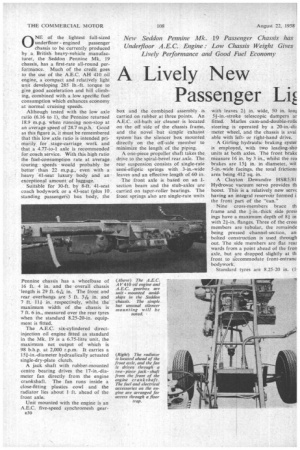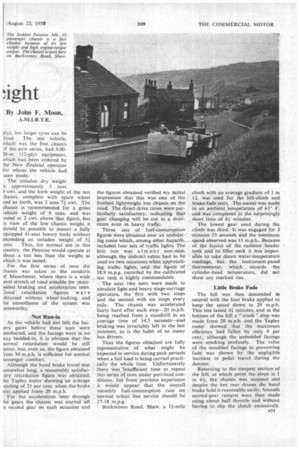A Lively New Passenger Li ight
Page 64

Page 65

Page 66

If you've noticed an error in this article please click here to report it so we can fix it.
By John F. Moon,
A.M.I.R.T.E.
ONE of the lightest full-sized underfloor engined passenger chassis to be currently produced by a British heavy-vehicle manufacturer, the Seddon Pennine Mk. 19 chassis, has a first-rate all-round performance. Much of the credit goes to the use of the AE.C. AH 410 oil engine, a compact and relatively light .unit .deveyoping 285 lb.-ft. torque to give .good acceleration and hill climbing, combined with a low specific fuel' consumption which enhances economy at normal cruising speeds.
Although. tested with the low axle ratio (616 to .1), the Pennine returned 18.9 M.p.g. When running non-stop at an average speed of 28.7 m.p.h. Good as this figure is, it Must be remembered that this low axle. ratio is intended priII:wily:far stage carriage work and that:a 4.77-to-1 axle is recommended for coach service. With this high ratio the fuel-consumption rate at average, touring seeds would probably be better". than 22 ni.p.g.,• even with a heavy : "41-seat' luxury body and an exceptional amount. of luggage. . Sititable' for 30-ft. by 8-ft. 41-seat coach bodywork or a 43-seat (plus 10.. standing passengers) bus body, the Pennine chassis has a wheelbase of 16 ft. 4 in. and the overall chassis length is 29 ft. 611,,in. The front and rear overhangs are 5 ft. 315-zin. and 7 ft. 11* in. respectively, whilst the maximum width of the chassis is 7 ft. 6 in., measured over the rear tyres when the standard 8.25-20-in, equipment is fitted.
The A.E.C. six-cylindered directinjection oil engine fitted as standard in the Mk. 19 is a 6.75-litre unit, the maximum net output of which is 98 b.h.p. at 2,000 r.p.m. It carries a 15f-in.-diameter hydraulically actuated single-dry-plate clutch.
A jack shaft with rubber-mounted centre bearing drives the 17-in.-diameter fan directly from the engine crankshaft. The fan runs inside a close-fitting plastics cowl and the radiator lies about 1 ft. ahead of the front axle.
Unit mounted with the engine is an A.E.C. five-speed synchromesh gearR30 box and the combined assembly is carried on rubber at three points. An A.E.C. oil-bath air cleaner is located on the off side of the chassis frame, and the novel but simple 'exhaust system has the' silencer box mounted directly on the off-side member to minimize the length of the piping.
A one-piece propeller shaft takes the drive to the spiral-bevel rearaxle: The rear suspension consists of single-rate semi-elliptic springs with 3-in.-wide' leaves and an effective length of 60 in.
The front axle is based on an 1section beam and the stub-axles are carried on taper-roller bearings. The front springs also are single-rate units with leaves 2+ in, wide, 50 in. lorq 5i-in.-stroke telescopic dampers ar fitted. Marks cam-and-double-rollc steering is operated by a 20-in.-di2 meter wheel, and the chassis is avai able with leftor right-hand drive.
A Girling hydraulic braking syster is employed, with two leading-she units at both axles. The front btake measure 16 in. by 3 in., whilst the rea brakes are 15+ in. in diameter, wit 5-in.-wide facings, the total friction2 area being 412 sq. in.
. A Clayton Dewandre HSR5/81 Hydrovac vacuum servo provides th boost. This is a relatively new serif( having art. integral reservoir formed i the front 'part of the "can."
Nine cross-members brace th frame and. the 1-in.-thick side press ings have a maximum depth of 8* in with 24--in. flanges. Three of the cross members are tubular, the remainde being pressed channel-section, an bolted construction is used through out. The side members are flat rear wards from a point ahead of the Iron axle, but are dropped slightly at th front to kcommodate front-entranc bodywork.
Standard tyres are 8.25-20 in. (11 aly), but larger tyres can be itted. The test vehicle, which was the first chassis )f the new series, had 9.00. (12-ply) equiprnent, which had been ordered by
the New Zealand operator for whom the vehicle had Deen made, ••• — The unladen -.dry weight .s approximately 3 tons 4. cwt.. and the kerb weight of the test thassis, complete with spare wheel ind so forth, was 3 tons 74 cwt. The chassis is recommended for a gross vehicle weight of 9 tons, and was :ested at 2 cwt. above that figure, but
view of the low chassis weight it ;hould . be possible to Mount a fully .quipped 41-seat luxury body without exceeding an unladen weight of :ons. Thus, for normal use in this .:ountry, the Pennine wouldoperate at tbout a ton less than the weight at which it was tested.
For the first series of tests the -.7hassis was taken to the outskirts Manchester, where there is a wide evel stretch..of road suitable for unim.)eded braking and acceleration tests. :load retardation figures were )btained without wheel-locking, and he smoothness . of the system was toteworthy.
...Not Rutt-in • • As the vehiele had not left the facj ory gates before these tests were onducted, and the facings were in no vay bedded-in, it is obvious, that the tormal retardation would be -still 'eller,: but, even so, the figure obtained !rorn..30 m.p.h. is sufficient for normal Iassenger comfort.
Although the hand brake travel was ;ornewhat long; a reasonably satisfac:dry' retardation figure .:Was obtained, he Tapley meter 'showing an "average -eadirig Of 23 per Cent. when thebrake viS1 applied from 20 m.p.h.
For the acceleration -tests 'through .gears the chassis was Started' off n second gear on each occasion and
the figures obtained verified my initial impression that this was one of the liveliest, lightweight bus chassis..ort the road. The direct-drive, times were par: tietilarly •satisfactOry, indicating that gear. changing will be cut to a Minimum even in heavy traffic.
• Three sets . df fuel-consumption :figures were obtained over an undulatitig route which.,..arnong other .hazards, included four sets of traffic lights. The first run • was al m oat non-stop, although the 'indirect ratios had to he used.on tvird occasions:when approaching traffic. light, arid the" .figure 18.9 :m.p.g. recorded by the calibrated test tank is highly commendable.
The next two, tests. were made to simulate light and heavy stage-carriage operation, the first with two stops and the second with six stops every mile. The chassis was accelerated fairly bard after each stop-20 m.p.h. being reached from a standstill in an average tithe of 14.5 seconds—and braking was invariably left to the last 'moment, as is the habit of so many bus drivers.
Thus the figures obtained are fully representative of what might be expected in service during peak periods when a full load is being carried practically the whole time. Unfortunately there Wasinsufficient time to repeat this series of tests under part-load con ... . . ditions, but from previous .experience it would appear that the overall rrionthly fuel-consumption rate on normal, urban bus service should be 17-18 m.p.g.
-Buekstones Road, Shaw. a 11-mile climb with an average gradient of 1 in 12, was used for the hill-climb and . brake-fade tests. The ascent was made in an ambient temperature of 630 and was completed in the Surprisingly short time of 64 minutes.
The lowest gear used during the climbwas third; It was. engaged for 3 Minutes -25 seconds and the minimum speed observed was 15 m.p.h. .Because of the layOut of the radiator, header lank and its filler neck it .Was'imposSible to: take direct Watentemperature readings, but the: instrunient,panel thermometer, which records the cylinder-head temperature, did. not show any marked rise.
Little Brake Fade
The hill was then descended in neutral with the foot brake applied to keep the speed down to 20 m.p.h. This test lasted 471 minutes, and at the bottom of the hill a " crash " stop was made from 20 mph. and the Tapley meter showed that the maximum efficiency had fallen by only 9 per cent., although the unbedded facings were smoking profusely. The value of the moulded facings in preventing fade was shown by the negligible increase in pedal travel during the descent
Returning to the steepest section of the hill, at which point the slope is 1 in 6-f, the chassis was stopped and despite the hot rear drums the hand brake held it reasonably easily. Smooth second-gear restarts were then made using about half throttle and without having to slip the clutch excessively. Acceleration and hill-climb performances obtained during the test seemed to indicate that the 4.77-to-1 axle ratio should be satisfactory even for bus working where there are no exceptionally steep hills.
Certainly the overall fuel consumption would be even' better and, in view of the high engine-torque output, the acceleration might also be improved. With the low-ratio axle the standard bottom gear of 6.25 to 1 should become necessary only when making restarts on hills steeper than 1 in 5.
Handles Well
The Pennine Mk. 19 chassis. handles well on the road, the steering being light but positive at normal speeds and by no means heavy at shunting pace. The castor action is of great assistance when cornering quickly.
Indeed, the cornering poWer of the chassis is such that the very sharp left-hand turn in the drive-way leading to the Seddon factory could be taken safely at almost 35 M.p.h., 'at which speed the small private car which was following became decidedly unstable.
The general liveliness of the chassis B32 was outstanding and the gearing gave a maximum speed of approximately 42 m.p.h.: this would be increased to about 54 m.p.h. with the 4.77-to-1 ratio. The suspension appeared to be adequate, so far as could be judged from the driving seat of an open chas sis. Only because the engine idlim speed had been set a little too low wa there any vibration transmitted to th+ frame; at higher speeds it wa absorbed by the rubber mountings.
Engine Maintenance ' So far as maintenance is concerned this new Seddon chassis follows fairl! conventional practice with respect t( the location of the main running units The engine accessories are placed s( that such items as the fuel-injectioi pump.. dynamo and starter can 13+ reached through a floor trap, whils the cylinder heads protrude fron below the off-side frame member fo easy access through hinged skir panels.
• The Pennine Mk. 19 chassis is onl! the second underfloor horizontal engined design to be produced 13! Seddon DieselVehicles, Ltd., but i proves to be a most satisfactory com bination of components. -Its simpliait! and standardized units ensure by initial cost and subsequent mainten ance expense, whilst the straight forward frame layout should simplif! body mounting.




















































































































